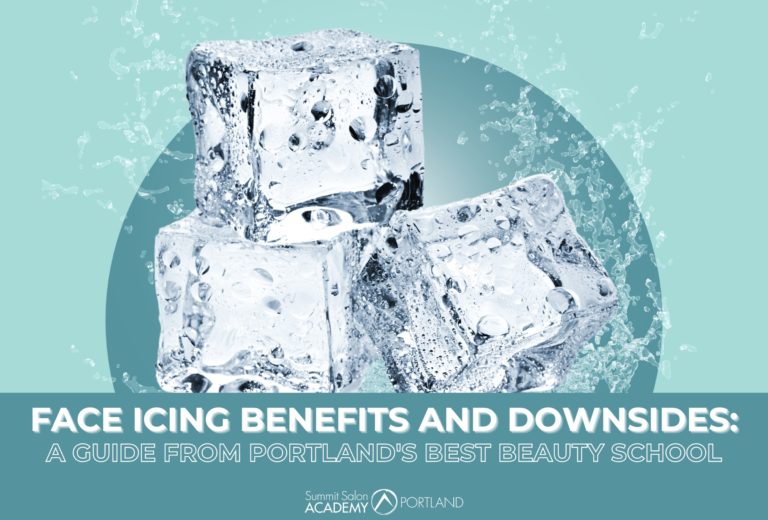Face icing is a popular skincare technique that has been making waves in the beauty industry. It’s a simple, low-cost treatment that involves rubbing ice cubes on the face. But what exactly does it do, and is it beneficial for everyone? As Portland’s best beauty school, we’re here to guide you through the chilling truth about face icing.
WHAT IS FACE ICING, AND THE SCIENCE BEHIND IT?

When ice is applied to the skin, the blood vessels contract, reducing inflammation and swelling. This is why we iced a bruised or sprained ankle. The same is true for the face. This is why beauty enthusiasts and experts have praised this for its numerous potential benefits. However, like with any skincare technique, there is no one-size-fits-all option.
BENEFITS OF FACE ICING
1. Soothes Acne
A study published in the Journal of Clinical and Aesthetic Dermatology (2023) found that cold therapy can help reduce acne inflammation. The cold temperature hinders the rate of chemical reactions, which can decrease the production of inflammation-causing substances.
2. Reduces Inflammation and Puffiness
The cold temperature from the ice constricts blood vessels, reducing inflammation and swelling. A study published in the World Journal of Plastic Surgery (2019) found that applying cold compresses can significantly reduce postoperative swelling in patients.
3. Shrinks Pores
Cold temperatures can cause pores to appear smaller, giving the skin a smoother appearance. Since the cold makes the skin and muscles contract, causing pores to appear tighter and less visible.
4. Enhances Product Absorption
Face icing can help close the pores temporarily, which can lock in the skincare products applied afterward, enhancing their absorption. Making the skincare routine more effective, as products can penetrate deeper and work more efficiently.
5. Boosts Circulation
The cold can stimulate blood flow to the face, nourishing the skin cells with oxygen and nutrients and giving the skin a healthy glow. This is because the body’s normal reaction to cold is to increase blood flow to maintain the body’s normal temperature.
DOWNSIDES OF FACE ICING
While face icing has its benefits, it’s not without its drawbacks.
1. Can Cause Redness
If you have sensitive skin, the cold temperature can cause redness and irritation if not done correctly.
2. Risk of Ice Burn
If ice is applied directly to the skin without a barrier like a cloth, it can cause ice burns or frostbite. Ice should never be applied directly to the skin; it must always be wrapped in a soft towel.
3. May Worsen Certain Conditions
People with conditions like rosacea or extreme sensitivity should avoid face icing as it can exacerbate these conditions.
WHO SHOULD AND SHOULDN'T USE FACE ICING
Face icing can be beneficial for most skin types, particularly those prone to acne or puffiness. However, those with sensitive skin or conditions like rosacea should consult a dermatologist before trying face icing.
HOW TO SAFELY ICE THE FACE
To ice the face safely, wrap the ice in a soft cloth and gently apply it to the face. Don’t leave the ice on one area too long to avoid frostbite. Always follow up with a moisturizer to keep the skin hydrated.
Face icing is a cool skincare trend with potential benefits. While it’s not a miracle cure-all, it could be a game-changer for your skincare routine. As always, always listen to your skin and consult a dermatologist if you have any concerns.
Are you inspired by the world of skincare and beauty? Summit Salon Academy of Portland, the leading cosmetology school in Oregon, offers comprehensive education in various beauty disciplines, including esthetics. If you’re ready to turn your passion into a profession, click here to learn more about our programs and how to enroll.




